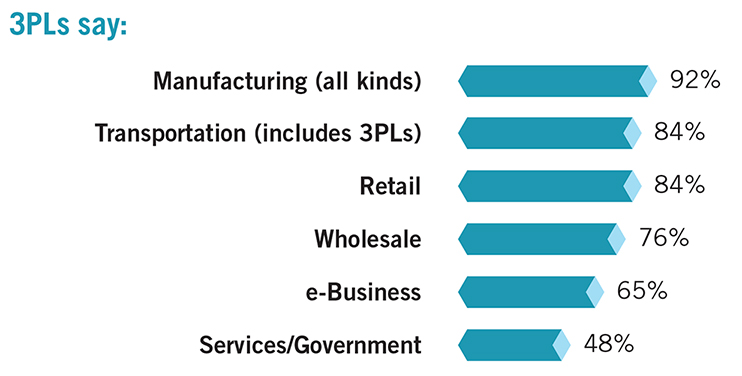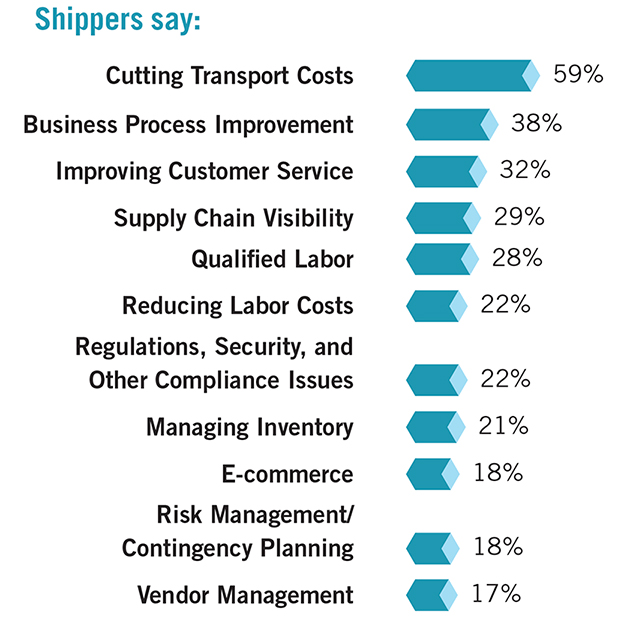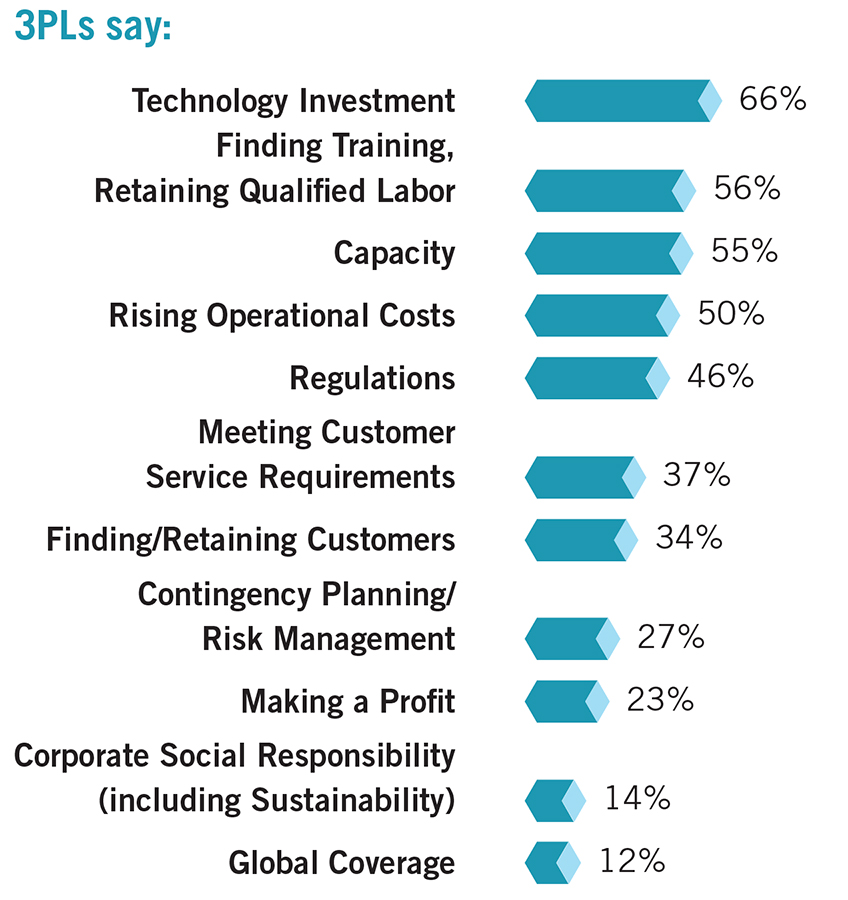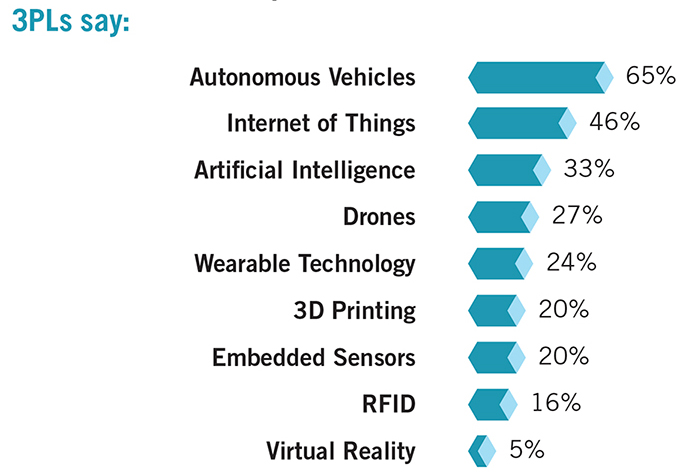3PL Perspectives 2017

Inbound Logistics’ 12th annual 3PL market research report provides a highlight reel of the trends and tribulations shaping logistics outsourcing strategy for both providers and shippers.
Perspectives Methodology
Spotlight on 3PLs
Find 3PL Partners
Market dynamics sit in the director’s chair when it comes to outsourcing decision-making. When the economy expands, manufacturers and retailers look outwardly to scale growth; as conditions erode, shippers leverage 3PL partners to optimize logistics functions and focus on core competencies.
Today, U.S. and global economies are betwixt and between, and anything but certain. Consider the litany of disruptions over the past year:
- The United Kingdom’s shock Brexit referendum
- Presidential impeachments in Brazil and South Korea…and perhaps Brazil again
- President Trump’s unlikely path to the White House
- OPEC and Russia’s unexpected agreement to curb oil production
- Hanjin’s bankruptcy
Closer to home, economic performance has been mired in stops and starts. At 4.3 percent, U.S. unemployment is at its lowest level in 16 years. Competition for labor is robust. But inflation is tepid.
Consumption has been erratic and unpredictable—2016 holiday retail sales notwithstanding—even as U.S. manufacturing rebounded from recession. Retailers were slow to destock and replenish, so inventories and inventory-to-sales ratios trended upward while freight volumes lagged behind.
On the regulatory front, an expected capacity crunch never materialized as the much-maligned Hours-of-Service and CSA rules ran out of steam. Looking ahead, the true impact of the FMCSA’s electronic logging device mandate is anyone’s guess.
When economics shade grey, 3PLs flaunt even greater influence, helping shippers manage change. But in today’s fast-spinning digital sphere, shippers need more.
Many manufacturers and retailers are experimenting on the edge as they dip their toes in digital technologies. It’s no small task. Supply chain management at its core is risk averse. Predictability and standardization are sacrosanct. Variation is reviled. Expectedly, shippers are relying on 3PLs to effect change, not just manage it.
Inbound Logistics‘ 12th annual 3PL Perspectives market research report pulls back the curtain to expose the trends and tribulations shaping logistics outsourcing strategy. Change agents are well documented. E-commerce is challenging traditional brick-and-mortar models while online retailers paradoxically aspire to set up shop closer to demand. Cloud computing is revolutionizing the ways businesses and consumers interact. And consumers wield leverage that captivates all.
The actors are familiar, too. Amazon and Walmart are butting heads as they compete for retail market share; Tesla, Apple, Microsoft, Uber, Facebook, Google, and GE are turning convention on end as they reinvent business models; and countless other players across industries are trying to stake a claim in a lawless, albeit fertile, omnichannel frontier.
In the 3PL space, incumbents and entrants alike are jockeying for position as market uncertainty and digital inevitability collide. Technology and talent democratize the playing field. Still, assets carry weight. Reducing cost and increasing customer service remain diametrically opposed deliverables. But consumers expect both. Shippers are depending on their 3PL partners to help parry tactical hurdles, and at the same time engage digital innovation.
Such is the dynamism in today’s changing logistics outsourcing market. Buckle up and welcome to 3PL Perspectives.
A sea-change shift is slowly sweeping across the business world. Supply chain and logistics functions are not only gaining traction in C-suite conversations, increasingly they command them. Look no farther than Tim Cook (Apple), Mary Barra (GM), Brian Krzanich (Intel), and Fabian Garcia (Revlon). At countless other companies, chief supply chain officers are climbing to the top, dragging with them newfound esteem from their corporate peers.
As logistics outsourcing grows mainstream, supply chain has become a strategic imperative. Outsourcing partnerships are following in lockstep.
Gone are the days of one-stop-shop, silver-bullet solutions. Shipper needs are nuanced by function, vertical, IT, and geographical regions. As testament to this growing specificity, 88 percent of shipper respondents use more than one 3PL (see Figure 1). This trend will continue.
FIGURE 1: How many 3PLs do you use?
Consequently, the outsourcing business remains strong. Eighty-six percent of service providers surveyed in Inbound Logistics‘ market research report have grown their client base by at least 5 percent over the past year; 89 percent have increased sales; and 81 percent have grown profits (see Figure 2).
FIGURE 2: During their last measurement period, 3PLs say the following were generally up or down:
There has been some attrition in profit margins over the past few years, largely attributed to rising labor costs and fluctuating fuel prices. U.S. unemployment remains low and e-commerce business continues to drive warehouse occupancy to record highs. 3PLs and shippers are equally challenged by operational costs. As logistics outsourcing becomes more strategic, there’s less of a transactional sting. It’s all about partnership and delivering value over time.
And, to the benefit of shippers, technology is compressing profit margin in certain areas—notably the freight brokerage space—where an emerging clique of Uber-for-freight players are disintermediating the ultimate intermediary.
The macro narrative? 3PLs continue to adapt and expand. Survey respondents share why:
- “Acquisitions and internal growth, as well as adding clients to multiple verticals.”
- “Added services, improved technology, API integration.”
- “Helping customers better control inbound logistics.”
- “As larger 3PLs get larger, customer service drops off. So we are able to pick up new customers frustrated with the lack of service from other providers.”
- “Continuous investment in proprietary technology for customers.”
- “Increase in dedicated business.”
- “Market conditions (impacted by ocean rates).”
- Growing with customers into new regions.
- “Our focus on technology, systems improvements, automated materials handling equipment, and training.”
The diversity of responses serves as yet another reminder of how varied the 3PL industry has become. What emerged as an extension of traditional transportation and warehousing functions one generation ago has exploded into a nuanced panoply of asset- and non-asset-based intermediaries.
Within the latter group, new competencies are emerging. There are track-and-trace aggregators; Uber-for-freight players in trucking, freight forwarding, and warehousing; managed transportation practitioners; IT developers moonlighting as 3PLs; e-commerce fulfillment specialists; and consultants—all of whom are moving the needle for their respective customers.
It’s also worth considering the myriad markets 3PLs serve. Manufacturing (92 percent), retail (84 percent), and wholesale (76 percent) have always been outsourcing standard-bearers (see Figure 3). E-business (65 percent) is a fast-growing niche as fulfillment complexity and customer service expectations grow—and e-commerce flows across borders. What’s notable is how attractive the transportation and 3PL space has become for 3PLs. Increasingly, service providers are collaborating with and selling through their peers.
FIGURE 3: Markets served
Cost and Service Are Top Levers
Shipper outsourcing priorities in 2017 remain similar to past years. Cutting transport costs is the top challenge, say 59 percent of respondents (see Figure 4). Business process improvement (38 percent), better customer service (32 percent), and supply chain visibility (29 percent) follow.
FIGURE 4: Most important challenges
“Cost” cuts across the supply chain. Whether it’s labor, transportation, or inventory, 3PLs need to deliver value across the terms of their contracts. Many leverage proprietary and/or outsourced technology capabilities to help shippers manage transportation and warehousing. Data analytics and logistics optimization capabilities allow intermediaries to better measure performance and improve services. If incumbents don’t deliver, a queue of competitors are waiting in line.
Asked which is more important, 75 percent of shippers favor service over price. Not surprisingly, 43 percent of surveyed shippers cite failed expectations as the primary reason for failed 3PL partnerships, closely followed by poor customer service (42 percent).
The “Amazon effect” has only amplified the importance of speed and agility in today’s marketplace. Aggregating visibility across the supply chain and continuously re-engineering business processes using technology and Lean/Six Sigma guidance often require external support. Businesses alone can’t meet shrinking lead times, cost pressures, and escalating consumer expectations. For small- and mi-sized businesses (SMBs) that don’t have the scale and shareholder patience of digital giants, collaboration is compulsory. Indeed, a number of 3PLs including FedEx, XPO, and the newly morphed Monarch FX alliance, are positioning themselves as mid-market e-commerce fulfillment providers—using their scale and resources to help retailers match Amazon’s “free shipping” trope at a fraction of the “real” cost. This has become another compelling reason for shippers to outsource post-click fulfillment. They can’t win otherwise.
To point, 86 percent of 3PL respondents specifically serve both large and small customers, while 9 percent target SMBs, and only 5 percent exclusively large companies.
3PLs face their own unique challenges—which provide greater insight into how outsourcing dynamics are changing. In 2017, 66 percent of 3PL survey respondents cite technology investment as their top priority, followed by recruiting and training talent (56 percent), capacity (55 percent), and rising operational costs (50 percent). (See Figure 5.)
FIGURE 5: Most important challenges
Technology investment first topped 3PL priorities in 2016— and that trend continues. The third-party logistics sector has become a wholesale channel for tapping best-of-breed solutions. From homegrown, proprietary data analytics engines to private-labeled TMS systems, in the cloud, on premise, or managed as a service, 3PLs are plugging in to compete.
Equally important is talent development. The “asset-light 3PL” has become a misnomer. More accurately, they flaunt intellectual property as a competitive advantage—engineers, data scientists, ops specialists, and project managers who are harnessing bleeding-edge innovation to deliver continuous value to their customers.
Flipping the Switch to Digital
Media and academia have widely documented how digital innovation is reshaping global supply chains. But the biggest disruptor is far closer to home: the consumer.
Technology is an enabler. But demand behavior is changing how retailers (both brick-and-mortar and online), wholesalers, manufacturers, and service providers deliver products and services to market. Changing demographics and digital disruption at the point of sale are reshaping the path to purchase, challenging industries and business models alike.
Consider how the automotive industry is adapting to digitalization. Automotive incumbents GM, Ford, Daimler, and Toyota are partnering with digital giants Apple and Google and tech entrepreneurs Tesla and Uber to redesign the way people and freight move. Cloud connectivity, autonomy, and “transportation-as-a-service” are collectively forcing automotive supply chain participants to collaborate and innovate in ways they’ve never done before. Similar changes are happening in the apparel, CPG, and grocery spaces as well.
Where are 3PLs experimenting on the edge? Autonomous vehicles tops the list of disruptive technologies that will have the greatest impact, according to 65 percent of 3PL respondents—followed by Internet of Things (46 percent), artificial intelligence (33 percent), drones (27 percent), and wearable technology (24 percent). (See Figure 6.)
FIGURE 6: Most disruptive innovations
Semi-autonomous trucks and platooning fleets may be closer in the side-view mirror than they appear—as 3PL consensus suggests. Railroads, Teamsters, and politicians will undoubtedly make noise to the contrary. But once safety is a proven deliverable—cost and sustainability are givens—technology that optimizes transportation and addresses latent driver shortages will eventually rise above these roadblocks.
The Internet of Things (IoT) is already disrupting supply chains. Embedded sensors and RFID are gathering data and allowing artificial intelligence-enabled systems to predict demand and prescribe actions. Humans are talking to machines, which, in turn, are interfacing with other machines. Wearable technologies, together with augmented and virtual reality capabilities, empower practitioners on the factory floor and inside the four walls to operate more efficiently. While Amazon’s well-publicized last-mile drone delivery in the UK commanded great attention, industry is quietly deploying similar assets to count inventory and track assets—with far greater ROI. Looking ahead, blockchain may disrupt supply chains in much the same way cloud computing has.
Retailers are especially sensitive to how innovation is triggering different consumer behaviors. Cognitive intelligence allows supply chains to dial in hyper-local demand; distributed order management and omnichannel strategies harmonize inventory visibility and control between different nodes in the supply chain. Accordingly, retailers have greater license to fulfill orders direct from store, from DC, or drop-shipped from the manufacturer. That’s the future of omnichannel management.
Upstream, these developments challenge manufacturers, wholesalers, and suppliers. Shrinking lead times and shifting order profiles from case-pick units to “eaches,” full truckload to less-than-truckload to multistop truckload, add variability and sub-optimize performance. Better demand visibility enables greater efficiency. Logistics optimization capabilities similarly empower stakeholders to account for changing demand and design optimal networks, leveraging 3PL partners and their assets to pool and deconsolidate freight where possible.
The net effect of digitalization? Supply chains are becoming more demand-driven. Amazon widely proselytizes its customer-centric business model. Many industries are similarly aligned—because they have to. Technology is bringing value chain partners closer together. Retailers no longer wield power; consumers do. Supply chain impatience and competition from incumbents and disruptors alike are compelling traditional “push” industries—where forecasting was once easily predictable—to pull to demand. It’s little wonder that “inbound logistics” tops the list of logistics services 3PLs provide (86 percent); and “demand-driven logistics” is the number-one strategy shippers and 3PLs are using to manage current market challenges.
Buffer Against Volatility
Geopolitical volatility around the world is impacting today’s logistics outsourcing paradigm. Rampant protectionism threatens entrenched perceptions of globalization as supply chains become more demand sensitive, risk averse, carbon conscious—and local. As supply chains become more decentralized, fewer 3PLs/4PLs will manage end-to-end capabilities. Shippers favor best-of-breed providers that are experts in their functional and geographic domains.
That’s not to suggest North American 3PLs are shrinking footprints. Quite the contrary. While the majority of shippers surveyed use 3PLs in North America (79 percent), Asia (29 percent), Europe (25 percent), and Southeast Asia/India (17 percent) are well represented (see Figure 7). 3PL global footprints align accordingly. Manufacturers and retailers are scanning the globe, looking for new markets to sell into and distribute through.
FIGURE 7: Regions where shippers outsource logistics
Given uncertainty around Trump Administration policies regarding NAFTA and cross-border trade, outsourcing global logistics functions helps shippers circumvent some risk. 3PLs are well positioned and connected via technology and partnerships to mitigate exposure and execute contingency plans when exceptions inevitably arise.
With regards to global transportation, ocean and air freight have been trending in different directions. Hanjin’s bankruptcy in 2016, and subsequent M&A activity and alliance jostling, underscore the institutional challenges steamship lines and ocean shippers have faced over the past few years. An inability to scale capacity to demand has forced carriers to idle ships and seek vessel-sharing agreements to better utilize capacity and prop up pricing.
While shippers and consignees have benefited from favorable rates in the short term, they are starting to feel the brunt of these changes. Ocean carriers benefit from larger vessels, better capacity utilization, and fewer ports of call. Costs and inefficiencies are pushed downstream in the supply chain. There will be more transshipment activity—and likely delays—flowing containers through congested, un-automated global gateways. 3PL value around import/export compliance and execution will remain strong.
Outsourcing demand for airfreight services is also growing. Global e-ecommerce is on the make. Borders are opening up and marketplaces such as Amazon and Alibaba make it easier for buyers and sellers to connect worlds apart. Linking first- and last-mile logistics presents challenges. Service is paramount for the consumer. Cost is important for the supply chain. Manufacturers/suppliers and retailers need to optimize LTL and courier transportation to and from origin and destination hubs, ensuring timely handoffs and customs documentation along the way. Growing protectionism only adds complexity. That benefits 3PLs operating in that space.
Perspectives Methodology
Spotlight on 3PLs
| ASSET-BASED OR NON-ASSET BASED | |
| Non-asset-based | 44% |
| Both | 43% |
| Asset-based | 12% |
| NUMBER OF WAREHOUSES | |
| 0 | 17% |
| 1-10 | 52% |
| 10-100 | 25% |
| 100+ | 6% |
| GEOGRAPHIC COVERAGE | |
| North America | 49% |
| Asia | 33% |
| Southeast Asia & India | 31% |
| Eastern Europe | 25% |
| Middle East & North Africa | 24% |
| U.S. Only | 23% |
| Europe | 13% |
| South America | 3% |
| VERTICAL SPECIALIZATION | |
| Consumer Packaged Goods (CPG) | 83% |
| Food & Beverage | 80% |
| Automotive | 75% |
| Construction & Building Materials | 74% |
| Electronics | 70% |
| Grocery | 68% |
| Apparel & Textiles | 67% |
| Healthcare | 65% |
| Furniture | 64% |
| Chemicals | 61% |
| Agriculture | 57% |
| Pharmaceuticals | 53% |
| Oil & Gas | 47% |
| Aerospace | 40% |
| Renewable Energy | 37% |
| Trade Show | 33% |
| LOGISTICS SERVICES | |
| Inbound Logistics | 86% |
| Integrated Logistics | 74% |
| JIT | 67% |
| Lead Logistics Provider/4th-Party Logistics | 66% |
| Inventory Management | 65% |
| Vendor Management | 62% |
| Logistics Process Reengineering | 54% |
| Shared Services | 52% |
| Payment Auditing/Processing | 47% |
| Global Trade Services | 36% |
| WAREHOUSING SERVICES | |
| Crossdocking | 78% |
| Transloading | 65% |
| Fulfillment | 64% |
| Pick/Pack, Subassembly | 64% |
| Vendor Managed Inventory | 61% |
| DC Management | 54% |
| Site Selection | 47% |
| NONE | 13% |
| TRANSPORTATION SERVICES | |
| Truckload | 95% |
| LTL | 90% |
| Intermodal | 82% |
| Rail | 73% |
| Dedicated Contract Carriage | 63% |
| Air Cargo | 59% |
| Ocean | 56% |
| Final Mile | 53% |
| Small Package | 54% |
| Final Mile | 53% |
| Bulk | 47% |
| Equipment/Drivers | 37% |
| Fleet Acquisition | 21% |
| SPECIAL SERVICES | |
| Logistics/Transportation Consulting | 86% |
| Direct to Store | 76% |
| Reverse Logistics/Product Lifecycle Management | 63% |
| Import/Export/Customs | 60% |
| Marketing/Customer Service | 54% |
| Sustainability/Green Logistics | 51% |
| Direct to Home | 47% |
| Foreign Trade Zone | 38% |
| Contingency/Crisis Planning | 32% |
| Labor Management | 29% |
| Security Analysis | 20% |
| TECHNOLOGY | |
| EDI | 95% |
| TMS | 85% |
| WMS | 62% |
| Visibility | 75% |
| Optimization | 73% |
| Freight Payment/Claims/Auditing | 56% |
| CRM/SRM | 63% |
| Wireless/RFID | 56% |
| ERP | 44% |
| Sustainability | 43% |
| Predictive Analytics | 39% |
| Global Trade Management | 28% |
AFind 3PL Partners
Research 3PL services and solutions ranked by Inbound Logistics
Request project pricing or information on 3PLs ranked by Inbound Logistics







